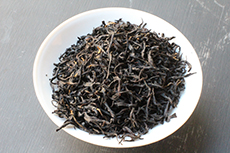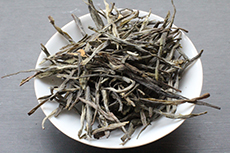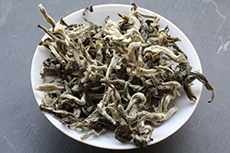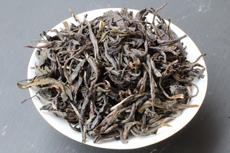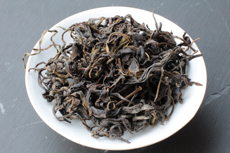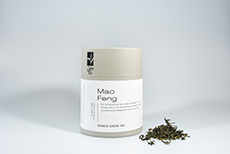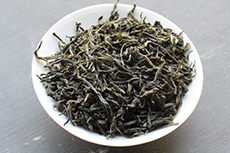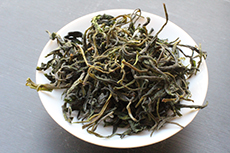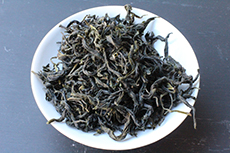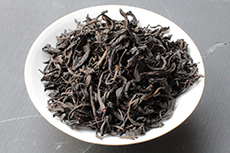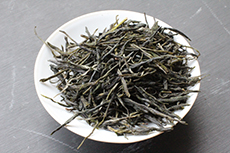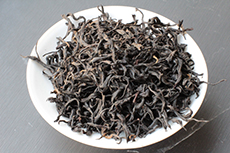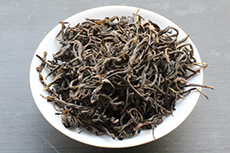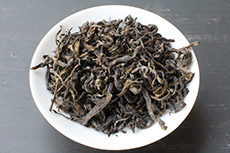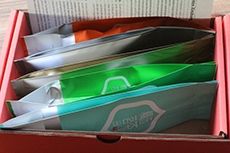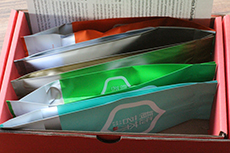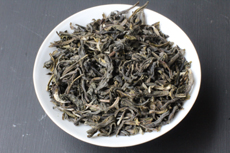.
Search results
Results 1 till 21 of a total of 21 (1 pages).
-
Blog Länggass-Tee
-
Qi Men Mao Feng
A Keemun black tea produced like a Mao Feng, it is of high quality. Mao Feng literally means Hairy Tip and designs a whole-leafed tea with big, twisted, regular leaves. -
Yun Nan Pine Needle
A good Yunnan green tea from the same family of producers as the Dian Hong, is also called Shimmering Silk because of its shimmering luster from the leaf hairs. Strong and sweet straight shaped Maofeng. -
White Monkey
White Monkey or Chinese Baimaohou is a green tea from Fuding, where usually White Teas are produced. Nice, relatively big leaf with white tips, crafted like a Maofeng. -
Sunon Yellow Tea
(Chinese Sheng An Huang Cha). Simple but good, typical and quaffable Huang Da Cha (big yellow tea), produced as a Maofeng. The production of this tea is relatively recent, however in a classic way, i.e. relatively dark and somewhat harsh in taste. Lightly roasted over charcoal.This tea is also available in the sustainably produced box of our Édition collection: Sunon Édition Classique -
Meng Ding Huang Da Cha
Very good everyday yellow tea. Da Cha means big tea and refers to the cheaper quality from large, late-picked leaves, shaped similar to the Meicha or Maofeng. This Mengding Huangdacha comes from tea gardens behind Mengding Mountain from tea plants of the old local Sichuan variety. It was traditionally processed as yellow tea, i.e. through traditional Menhuang - humid/sticky yellowing, lasting at least 96 hours. The leaves are packed for about 24 hours at a time and fermented at high humidity and about 40°C, with more heat added in between depending on the condition and changes that have taken place. This whole process is difficult to control (the tea can suffocate and thus break) and very labour-intensive. Finally, the tea was roasted or dried three times over charcoal.Mengding is probably the oldest tea-growing area that is not wild, i.e. planted by humans. -
Mao Feng Édition Classique
A Chinese green tea classic for every day. Full-bodied, rounded and mellow, this wonderful tea can be enjoyed at any time of day. -
Wu Lü
A good green tea crafted like a Mao Feng. Dark-leaved. Wulü means beautiful green, however also designs green tea from Wuyuan, a place in Jiangxi. -
Huang Shan Mao Feng
The area around the Yellow Mountains, in Chinese: Huang Shan, in the province of Anhui, is believed to be the cradle of Maofeng. Huangshan Maofeng is a classic Maofeng with a twisted leaf. -
Mao Feng
A very good, flowery and quaffable Mao Feng for every day from the province of Hunan at a very good price. Also known as Cui Lü.This tea is also available in the sustainably produced box of our Édition collection: Mao Feng Édition Classique -
Chuan Hong Mao Feng
A very good black tea from Sichuan with an intense taste of roses that naturally belongs to this tea. Also called Sichuan Gongfu. -
Da Bai
-
Meng Ding Mao Feng
A very nice, slightly tart Zhi Mao Feng from the region around Mengding in the province of Sichuan. Zhi Mao Feng means: the Maofeng shaped as a straight leaf.Mengding is probably the oldest area where tea has been cultivated by man, i.e. not harvested from wild growing tea bushes. -
Tan Yang Mao Feng
A real Gong Fu Cha from Tan Yang village, but bought before the process of sifting, where the tea is sorted by size of the leaves. Traditional processing, and the final roasting took place over charcoal.Tan Yang Gong Fu is one of the ancient traditional Minhong Gongfu, which have been famous since 1851. Most of the Gongfucha that can be found today are produced in a modern form in the manner of Jin Jun Mei, using buds only. This Tan Yang Maofeng was produced in the traditional way as a Gongfu Maocha. It is called Maocha, unfinished tea, because we bought it before the very last step of its production was performed, where the leaves are mechanically sifted and sorted according to the size of the leaves.(Formerly, we carried this tea ander the name Tan Yang Superior) -
Huo Shan Huang Xiao Cha
A good yellow tea, processed as Mao Feng or Maojian. Huang Xiao Cha means Small Yellow Tea and refers to the better quality of the later harvest, while Huang Da Cha (Big Yellow Tea) would be the cheapest quality, and Huangya the most refined one from buds only. Huoshan Huangya is one of the classic yellow teas, like other yellow teas, is usually produced in a very green way, as it is the contemporary trend. It can thus hardly be differentiated from green teas. This Huoshan Huangxiaocha, however, has been produced in a classic way, really yellow, through the traditional Menhuang process: packed and piled up in portions over several days, it turned or sweat itself yellow. From time to time those packages of tea leaves are unpacked and then wrapped up again. Finally dried above charcoal. -
Meng Ding Huang Xiao Cha
A good yellow tea, processed as Mao Feng or Maojian. Huang Xiao Cha means Small Yellow Tea and refers to the better quality of the later harvest, while Huang Da Cha (Big Yellow Tea) would be the cheapest quality. The plucking material for this Mengding Huangxiaocha comes from the same tea garden as the Meng Ding Huang Ya and is processed like the latter in the classic way as yellow tea, i.e. through traditional Menhuang - humid/sticky yellowing, lasting at least 96 hours. The leaves are packed for about 24 hours at a time and fermented at high humidity and about 40°C, with more heat added in between depending on the condition and changes that have taken place. This whole process is difficult to control (the tea can suffocate and thus break) and very labour-intensive. Finally, the tea was roasted or dried three times over charcoal.Mengding is probably the oldest tea-growing area that is not wild, i.e. planted by humans. -
No. 15 Grüntee Varianten Xinchang
Five special teas from the same producer, two of them from overgrown tall tea plants, two hand-processed and lightly roasted over charcoal. Two of the five teas have been in Länggass-Tee's range for some time, the last three are exclusively in this set. Pan, a producer who is considered as a tea maniac in his town, has extensive tea gardens in the hills around Xinchang and produces various teas from a wide range of tea plant varieties of exceptional quality. He also produces green teas from other tea gardens in Zhejiang province, and more recently from old tea bushes in overgrown tea gardens.In addition to the origin and variety of the tea plant, the shape also plays a major role in the taste of a tea. Throughout China, different green tea processing methods exist, which can be divided into categories according to shape.This set now unites different processing forms of Chinese green teas: Maojian and Maofeng as spirally curved teas, a flat-form tea and two pearl teas from two different tea plant varieties.Contents: 25g Jin Jiang Hui Ming, 25g Fo Xiang Bai Cha, 25g Tan Bei Yun Wu, 25g Ye Sheng Mao Feng, 25g Ye Sheng Long Jing. -
Grüntee Varianten Xinchang
Five special teas from the same producer, two of them from overgrown tall tea plants, two hand-processed and lightly roasted over charcoal. Two of the five teas have been in Länggass-Tee's range for some time, the last three are exclusively in this set. Pan, a producer who is considered as a tea maniac in his town, has extensive tea gardens in the hills around Xinchang and produces various teas from a wide range of tea plant varieties of exceptional quality. He also produces green teas from other tea gardens in Zhejiang province, and more recently from old tea bushes in overgrown tea gardens.In addition to the origin and variety of the tea plant, the shape also plays a major role in the taste of a tea. Throughout China, different green tea processing methods exist, which can be divided into categories according to shape.This set now unites different processing forms of Chinese green teas: Maojian and Maofeng as spirally curved teas, a flat-form tea and two pearl teas from two different tea plant varieties.Contents: 25g Jin Jiang Hui Ming, 25g Fo Xiang Bai Cha, 25g Tan Bei Yun Wu, 25g Ye Sheng Mao Feng, 25g Ye Sheng Long Jing. -
Green Tea China
-
Newsletter Länggass-Tee November 2016
04. November 2016 Newsletter November 2016 von Länggass-Tee
-
Vietnam grün
Simple and good green tea from Vietnam, produced in the way of chinese Maofeng. In the south of Vietnam this tea is often served chilled on ice, and then it is called Tra Da (tea on ice).
.






